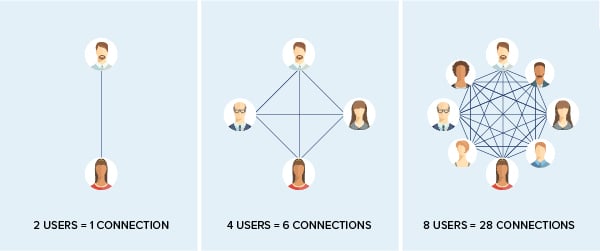A question often asked in AR circles is “what will be the killer app?” The sector needs a killer app to break out of niche status and fulfill its vision for a more ubiquitous medium. And the growing consensus is that the killer app will be social.
For example, in Charlie Fink’s Metaverse, Fink predicts that the killer app for AR (and VR for that matter) will be other people. Like other technologies before it, XR will find its place as a tool to amplify our innate human need to interact with each other. It should connect more than it isolates.
Beyond catering to our humanity, social components accelerate growth for any technology. This gets to network effect, wherein the value of networked products grow exponentially with every node added. Network-effect maestro Bob Metcalfe even believes AR’s killer app will be networked.
“It’s very likely that the killer app will be networked AR,” Metcalfe said at January’s ARIA conference at MIT. “Facebook came from nowhere based on the value of networking and it continues to grow. Their company is booming based on the value of connectivity.”

Persistence Pays
Social features also work towards a key tactic in app design, which is to engender active and repeat use. As we discussed with Snaappy, social messaging is an inherently sticky behavior. Social was also the second most-used AR app category in our just-released consumer survey.
Messaging is just one social component, and has driven one of AR’s most prevalent use case so far — Snapchat lenses. But where social AR will really manifest is collaboration. That boils down to multi-player support, as well as image persistence accross sessions and between users.
This will be a key AR building block in the next few years. Super Ventures partner Ori Inbar characterizes AR’s current stage like browsing the web in 1999: It’s mostly a solo experience. But we need to get to that 2005 web 2.0 stage when it became much more social and collaborative.
The multi-player support and image persistence required to get to that stage could be accelerated by platform-level (ARkit and ARCore) functionality that developers can tap into. But we’ve heard rumors that it’s back-burnered for a few more SDK revisions, at least in ARkit’s case.
Filling the Gaps
Meanwhile, there are a few home-grown efforts getting there faster. YouAR, Membit, 6D.ai, Escher Reality and Ubiquity6 are a few. And Google is the sleeping giant with lots of data that could lay the foundation for geo-relevant object data for persistent AR (think: Street View).
What we’re talking about here is essentially the AR Cloud and an “internet of places.” As we’ve examined — and as Fink astutely covered more recently — the above efforts represent mini-AR clouds that will fill important gaps until we get to a more federated AR cloud.
Meanwhile, other important questions loom, such as the front-end. For example, are apps the wrong AR vessel? There’s access/download friction and platform fragmentation, which creates interoperability between users, which in turn mitigates network effect. Enter web XR.
The reason this is all important is to give multiplayer AR a frictionless path to network effect. Once we get that image persistence and interoperability at the platform level, things could get a lot more social, fast. That will lay the groundwork for killer apps — and thus industry growth — to follow.
For a deeper dive on AR & VR insights, subscribe to ARtillry Intelligence Briefings, and sign up for the free ARtillry Weekly newsletter.
Disclosure: ARtillry has no financial stake in the companies mentioned in this post, nor received payment for its production. Disclosure and ethics policy can be seen here.

